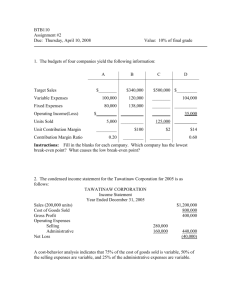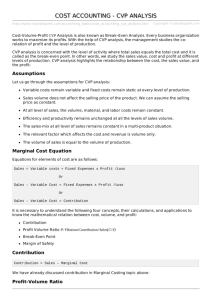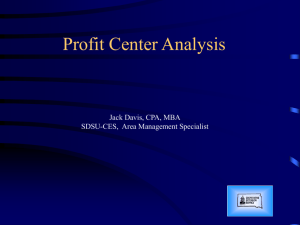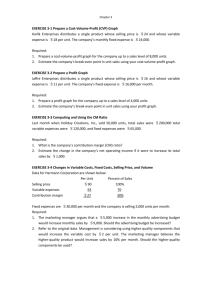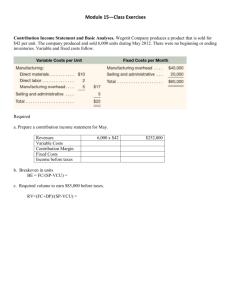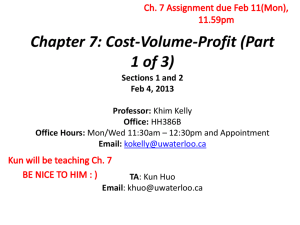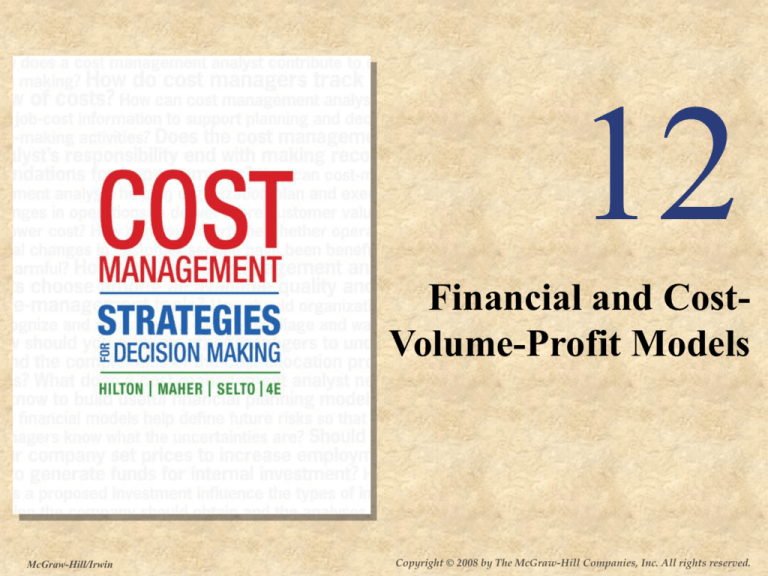
12
Financial and CostVolume-Profit Models
McGraw-Hill/Irwin
Copyright © 2008 by The McGraw-Hill Companies, Inc. All rights reserved.
12-2
Learning Objective 1
12-3
Definition of Financial Models
Accurate, reliable
simulations of
relations among
relevant costs,
benefits, value and
risk that are useful for
supporting business
decisions.
Relationships
between costs,
revenues, &
income.
Pro forma
financial
statements.
Relationships
between
current
investments
and value.
12-4
Objectives of Financial Modeling
To improve the
quality of
decisions
To allow flexible and
responsive analyses
To simulate accurately
and reliably the
relevant factors
and relationships
12-5
Learning Objective 2
12-6
Basic Cost-Volume-Profit (CVP)
Model
Revenue = Variable Costs + Fixed Costs + Income
Assumptions:
Revenue can be estimated as:
sales price (P) × units sold (Q)
Total variable costs can be estimated as:
variable cost per unit (V) × units sold (Q)
Total fixed costs (F) will remain constant
over the relevant range.
12-7
Basic CVP Model and
the Break-Even Point
Revenue = Variable Costs + Fixed Costs + Income
PQ = VQ + F + I
At the break-even point income = 0
PQ = VQ + F
Combining terms and solving for Q, the number
of units that must be sold to break even:
Q = F ÷ (P – V)
(P – V) is the unit
contribution margin
Let’s see
some
numbers!
12-8
Basic CVP Model and
the Break-Even Point
The break-even point is the point in the volume of
activity at which the organization’s revenues and
expenses are equal.
Sales
$ 200,000
Less: variable expenses 120,000
Contribution margin
80,000
Less: fixed expenses
80,000
Net income
$
-
12-9
Basic CVP Model and
the Break-Even Point
Consider the following information
developed by the accountant at Curl, Inc.:
Sales (500 surf boards)
Less: variable expenses
Contribution margin
Less: fixed expenses
Net income
Total
$250,000
150,000
$100,000
80,000
$ 20,000
Per Unit
$
500
300
$
200
Percent
100%
60%
40%
12-10
Basic CVP Model and
the Break-Even Point
For each additional surf board sold, Curl
generates $200 in contribution margin.
Sales (500 surf boards)
Less: variable expenses
Contribution margin
Less: fixed expenses
Net income
Total
$250,000
150,000
$100,000
80,000
$ 20,000
Per Unit
$
500
300
$
200
Percent
100%
60%
40%
12-11
Basic CVP Model and
the Break-Even Point
Fixed expenses
Unit contribution margin
Sales (500 surf boards)
Less: variable expenses
Contribution margin
Less: fixed expenses
Net income
$80,000
$200
Break-even point
=
(in units)
Total
$250,000
150,000
$100,000
80,000
$ 20,000
Per Unit
$
500
300
$
200
= 400 surf boards
Percent
100%
60%
40%
12-12
Basic CVP Model and
the Break-Even Point
Here is the proof!
Sales (400 surf boards)
Less: variable expenses
Contribution margin
Less: fixed expenses
Net income
400 × $500 = $200,000
Total
$200,000
120,000
$ 80,000
80,000
$
-
Per Unit
$
500
300
$
200
Percent
100%
60%
40%
400 × $300 = $120,000
12-13
Basic CVP Model and
the Break-Even Point
Calculate the break-even point in sales dollars
rather than units by using the contribution
margin ratio.
Contribution margin
Sales
Fixed expense
CM Ratio
= CM Ratio
Break-even point
=
(in sales dollars)
12-14
Basic CVP Model and
the Break-Even Point
Sales (400 surf boards)
Less: variable expenses
Contribution margin
Less: fixed expenses
Net income
$80,000
40%
Total
$200,000
120,000
$ 80,000
80,000
$
-
Per Unit
$
500
300
$
200
Percent
100%
60%
40%
= $200,000 sales
12-15
Basic CVP Model in Graphical
Format
Summarizing CVP relationships in a graph makes
more information available to managers in less
space, and makes the relationships more intuitive.
Consider the following information for Curl, Inc.
300 units
Sales
$ 150,000
Less: variable expenses
90,000
Contribution margin
$
60,000
Less: fixed expenses
80,000
Net income (loss)
$ (20,000)
400 units
$ 200,000
120,000
$ 80,000
80,000
$
-
500 units
$ 250,000
150,000
$ 100,000
80,000
$
20,000
12-16
Basic CVP Model in Graphical
Format
450,000
Total sales
Break-even
point
400,000
350,000
300,000
Total expenses
250,000
200,000
Fixed expenses
150,000
100,000
50,000
-
100
200
300
400
Units Sold
500
600
700
800
12-17
Profit-Volume Graph
Some managers like the profit-volume
graph because it focuses on profits and volume.
$100,000
$80,000
$60,000
$40,000
$20,000
$$$(20,000)
$50
$100
$150
$200 $250
$300
$350
$400
$(40,000)
Break-even
point
$(60,000)
$(80,000)
$(100,000)
1
2
3
4
Units sold (00s)
5
6
7
8
12-18
CVP and Target Income
We can determine the number of
surfboards that Curl must sell to earn a
profit of $100,000 using the contribution
margin approach.
Fixed expenses + Target income
Units sold to earn
=
Unit contribution margin
the target income
$80,000 + $100,000
$200 per surf board
= 900 surf boards
12-19
CVP and Target Income
We can also use the equation approach
to get the same result.
Revenue = Variable costs + Fixed costs + Income
($500 × Q) =
($300 × Q) + $80,000 + $100,000
$200Q
= $180,000
Q = 900 surf boards
12-20
Operating Leverage
Reflects the risk of missing sales targets.
Measured as the ratio of contribution
margin to operating income.
A high operating
leverage is indicative
of high committed
costs (e.g. interest).
A relatively small
change in sales can
lead to a loss.
A low operating
leverage is indicative
of low committed
costs (e.g. interest).
More of the costs are
variable in nature.
12-21
Operating Leverage
Operating leverage
factor
=
Contribution margin
Net income
Actual sales
500 Board
Sales
$ 250,000
Less: variable expenses
150,000
Contribution margin
100,000
Less: fixed expenses
80,000
Net income
$
20,000
$100,000
$20,000
= 5
12-22
Operating Leverage
A measure of how a percentage change in
sales will affect profits. If Curl increases
its sales by 10%, what will be the
percentage increase in net income?
Percent increase in sales
Operating leverage factor ×
Percent increase in profits
10%
5
50%
Here’s the proof!
12-23
Operating Leverage
Actual sales
(500)
Sales
$ 250,000
Less variable expenses
150,000
Contribution margin
100,000
Less fixed expenses
80,000
Net income
$
20,000
Increased
sales (550)
$ 275,000
165,000
110,000
80,000
$
30,000
10% increase in sales from
$250,000 to $275,000 . . .
. . . results in a 50% increase in
income from $20,000 to $30,000.
12-24
Learning Objective 3
12-25
Computer Spreadsheet Models
1. Gather all the
facts, assumptions
and estimates for
the model; i.e.,
parameters.
2. Describe the relations
between the parameters.
This usually results in an
algebraic equation.
3. Separate the parameters
from the formulas. Use
cell addresses, instead of
actual numbers.
12-26
Learning Objective 4
12-27
Modeling Taxes
We can adjust the basic CVP
model to incorporate income taxes.
Use the following notation:
A = Income after tax
B = Income before tax
T = Tax rate
A = B – BT
A = B (1 – T) or solving for B:
B = A ÷ (1 – T)
12-28
Modeling Multiple Products
When a company sells
multiple products, modeling
requires:
1. An estimate of the
relative proportion of each
product in the sales mix
2. A computation of the
Weighted Average Unit
Contribution Margin
12-29
Modeling Multiple Products
For a company with more than one product,
sales mix is the relative combination in which a
company’s products are sold.
Different products have different selling prices,
cost structures, and contribution margins.
Let’s assume Curl sells surf boards and sail
boards. Then we’ll calculate a break-even point
that encompasses both products and their
cost-price parameters.
12-30
Modeling Multiple Products
Curl provides us with the following information:
Description
Surfboards
Sailboards
Total sold
Unit
Unit
Number
variable contribution
of
cost
margin
boards
500 $ 300 $
200
500
1,000
450
550
300
800
Selling
price
$
Description
Sales mix
computation
Surfboards
Sailboards
Total sold
Number
of boards
500
300
800
% of
Total
62.5% (500 ÷ 800)
37.5% (300 ÷ 800)
100.0%
12-31
Modeling Multiple Products
Weighted-average unit contribution margin
Contribution
Weighted
Description
% of total
margin
contribution
Surfboards $
200
62.5% $
125.00
Sailboards
550
37.5%
206.25
Weighted-average contribution margin $
331.25
$200 × 62.5%
12-32
Modeling Multiple Products
Break-even point
Break-even
Fixed expenses
=
point
Weighted-average unit contribution margin
Break-even
=
point
$170,000
$331.25
Break-even
= 514 combined units
point
Fixed costs increased
from $80,000, due to
expansion needed to
sell multiple products.
12-33
Modeling Multiple Products
The break-even point is 514 combined units. We can use
the sales mix to find the number of units of each
product that must be sold to break even.
Combined
break-even
sales
514
Product
Surfboards
Sailboards
Total units
% of
total
62.5%
37.5%
Individual
sales
321
193
514
The break-even point of 514 units is valid
only for the sales mix of 62.5% and 37.5%.
12-34
Modeling Multiple Cost Drivers
An insight from activity-based
costing: costs may be a
function of multiple activities,
not merely sales volume.
Some costs
treated as fixed
(when sales
volume is the only
activity) may now
be considered
variable.
Total Cost =
(Unit variable cost × Sales units)
+ (Batch cost × Batch activity)
+ (Product cost × Product activity)
+ (Customer cost × Customer activity)
+ (Facility cost × Facility activity)
12-35
Learning Objective 5
12-36
Sensitivity Analysis
An examination of the changes in outcomes caused
by changes in each of a model’s parameters.
For example, we can examine the impact on Curl’s
profit (outcome) if the parameters of selling price, quantity
sold, unit variable cost, and/or fixed costs change.
Because of the number of computations involved,
computerized models are used for sensitivity analysis.
12-37
Sensitivity Analysis
Estimate
the likely
range of each
parameter.
Estimate
the most
likely value
of each
parameter.
Change one parameter
to upper and lower end
of range, keeping other
parameters at the most
likely values.
Record profit
for each change
and repeat
process for
all parameters.
Because of the number of computations involved,
computerized models are used for sensitivity analysis.
12-38
Sensitivity Analysis
Model elasticity
The ratio of percentage change
in outcome (profit) to percentage
change in an input parameter.
If greater than 1.0:
the change in parameter
has a significant effect
on profit.
If less than 1.0:
the change in parameter
has a negligible effect
on profit.
Because of the number of computations involved,
computerized models are used for sensitivity analysis.
12-39
Scenario Analysis
Realistic combinations of changed parameters
Best case scenario
Realistic combination
of highest prices and
quantities, along with
the lowest costs.
Worst case scenario
Realistic combination
of lowest prices and
quantities, along with
the highest costs.
Most likely case scenario
Realistic combination of
most likely prices and
quantities, along with the
most likely costs.
12-40
Learning Objective 6
12-41
Modeling Scarce Resources
Firms often face the problem of deciding
how to best utilize a scarce resource.
Usually fixed costs are not affected by this
particular decision, so management can
focus on maximizing total throughput
(usually equal to contribution margin).
Let’s look at the Rose Company example.
12-42
Modeling Scarce Resources
Rose Company produces three products.
Selected data are shown below.
Selling price per unit
Less variable expenses per unit
Contribution margin per unit
Current demand per week (units)
Contribution margin ratio
Processing time required
on machine A1 per unit (min.)
Product
2
3
1
$
60
$
50
$
40
36
35
20
$
24 $
15 $
20
2,000
2,200
1,500
40%
30%
50%
1.00
0.50
0.80
12-43
Modeling Scarce Resources
Operating time on machine A1 is the scarce
resource, as it is being used at 100% of its
capacity.
There is excess capacity on all other machines.
Machine A1 has a capacity of 2,400 minutes per
week.
Which product should Rose emphasize
next week?
12-44
Modeling Scarce Resources
The key is the contribution margin
per unit of the scarce resource.
Contribution margin per unit
Minutes required to produce one unit
Contribution margin per minute
Product
1
2
3
$
24 $
15 $
20
1.00
0.50
0.80
$ 24.00 $ 30.00 $ 25.00
Product 2 should be emphasized because it has the highest
contribution per minute on machine A1, the scarce resource.
If there are no other considerations, the best plan would be to
produce to meet current demand for Product 2 and then use
remaining capacity to make Product 3.
12-45
Modeling Scarce Resources
Let’s see how this plan would work.
Alloting Our Constrained Recource (Machine A1)
Weekly demand for Product 2
Time required per unit
Total time required to make
Product 2
×
2,200 units
0.50 min.
1,100 min.
12-46
Modeling Scarce Resources
Let’s see how this plan would work.
Alloting Our Constrained Recource (Machine A1)
Weekly demand for Product 2
Time required per unit
Total time required to make
Product 2
Total time available
Time used to make Product 2
Time available for Product 3
×
2,200 units
0.50 min.
1,100 min.
2,400 min.
1,100 min.
1,300 min.
12-47
Modeling Scarce Resources
Let’s see how this plan would work.
Alloting Our Scarce Recource (Machine A1)
Weekly demand for Product 2
Time required per unit
Total time required to make
Product 2
Total time available
Time used to make Product 2
Time available for Product 3
Time required per unit
Production of Product 3
Is this a problem?
×
2,200 units
0.50 min.
1,100 min.
÷
2,400
1,100
1,300
0.80
1,625
min.
min.
min.
min.
units
12-48
Modeling Scarce Resources
The market for Product 3 is only 1,500 units per
week, so Rose should not produce 1,625 units.
So Rose should produce 1,500 units of Product 3,
leaving time to produce how many Product 1?
12-49
Modeling Scarce Resources
Alloting Our Scarce Recource (Machine A1)
Weekly demand for Product 3
Time required per unit
Total time required to make
Product 3
Remaining time available
Time used to make Product 3
Time available for Product 1
Time required per unit
Production of Product 1
×
1,500 units
0.80 min.
1,200 min.
÷
1,300
1,200
100
1.00
100
min.
min.
min.
min.
units
12-50
Modeling Scarce Resources
Suppose Rose Company could buy additional
minutes of capacity on machine A1.
How many additional minutes does Rose need
to satisfy unmet sales demand?
Rose had only 100 minutes remaining for Product 1
which requires 1.00 minutes per unit. The weekly demand
for Product 1 is 2,000 units. Rose needs an additional 1,900
minutes to produce enough Product 1 to satisfy demand.
12-51
Modeling Scarce Resources
What is the maximum amount Rose would pay per minute
for the additional 1,900 minutes to produce Product 1?
Contribution per minute for Product 1 is $24.00. Rose
could pay up to $24.00 per minute for additional capacity.
12-52
Modeling Scarce Resources
Now, assume that the demand for all three
products is unlimited and that Rose company
could again buy additional
minutes of capacity on machine A1.
What is the maximum amount Rose would
pay per minute for additional capacity?
Contribution per minute for Product 2 is $30.00. Rose
could pay up to $30.00 per minute for additional capacity
as long as Product 2 could be sold.
12-53
Learning Objective 7
12-54
Theory of Constraints
Popularized in the book The Goal
Seeks to improve product processes
by focusing on constrained resources
Measures process capacity, identifies
constraints and responds effectively
Pays close attention to “bottlenecks”
that limit production or sales.
12-55
Theory of Constraints – Six Step Process
1.
2.
3.
4.
5.
6.
Identify the appropriate measure of value
created – this will typically be throughput.
Identify the organization’s bottleneck.
Use the bottleneck to produce only the
most highly valued products.
Synchronize all other processes to the
bottleneck.
Increase the bottleneck’s capacity or
outsource the production of its output.
Avoid inertia; find the next bottleneck.
12-56
Learning Objective 8
12-57
Linear Programming
Applied to production situations with
multiple products and constraints
Constraints represent capacity limits
of the processes and resources
Used to help find the product mix
that maximizes profits
There may be many feasible input
and output combinations that satisfy
the constraints, but this technique
helps find the optimum point at
which profits are maximized
Assumption: that all relationships in
the model are linear
12-58
End of Chapter 12


